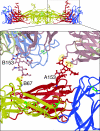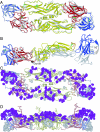Variable surface epitopes in the crystal structure of dengue virus type 3 envelope glycoprotein
- PMID: 15613349
- PMCID: PMC538574
- DOI: 10.1128/JVI.79.2.1223-1231.2005
Variable surface epitopes in the crystal structure of dengue virus type 3 envelope glycoprotein
Abstract
Dengue virus is an emerging global health threat. The major envelope glycoprotein, E, mediates viral attachment and entry by membrane fusion. Antibodies that bind but fail to neutralize noncognate serotypes enhance infection. We have determined the crystal structure of a soluble fragment of the envelope glycoprotein E from dengue virus type 3. The structure closely resembles those of E proteins from dengue type 2 and tick-borne encephalitis viruses. Serotype-specific neutralization escape mutants in dengue virus E proteins are all located on a surface of domain III, which has been implicated in receptor binding. While antibodies against epitopes in domain I are nonneutralizing in dengue virus, there are neutralizing antibodies that recognize serotype-conserved epitopes in domain II. The mechanism of neutralization for these antibodies is probably inhibition of membrane fusion. Our structure shows that neighboring glycans on the viral surface are spaced widely enough (at least 32 A) that they can interact with multiple carbohydrate recognition domains on oligomeric lectins such as DC-SIGN, ensuring maximum affinity for these putative receptors.
Figures




References
-
- Altmann, F., E. Staudacher, I. B. Wilson, and L. Marz. 1999. Insect cells as hosts for the expression of recombinant glycoproteins. Glycoconj. J. 16:109-123. - PubMed
-
- Beasley, D. W., and J. G. Aaskov. 2001. Epitopes on the dengue 1 virus envelope protein recognized by neutralizing IgM monoclonal antibodies. Virology 279:447-458. - PubMed
-
- Brünger, A. T., P. D. Adams, G. M. Clore, W. L. DeLano, P. Gros, R. W. Grosse-Kunstleve, J. S. Jiang, J. Kuszewski, M. Nilges, N. S. Pannu, R. J. Read, L. M. Rice, T. Simonson, and G. L. Warren. 1998. Crystallography & NMR System: a new software suite for macromolecular structure determination. Acta Crystallogr. D Biol. Crystallogr. 54:905-921. - PubMed
-
- Burke, D. S., and T. P. Monath. 2001. Flaviviruses, p. 1043-1125. In D. M. Knipe, P. M. Howley, D. E. Griffin, S. R. A. Lamb, M. A. Martin, B. Roizman, and S. E. Straus (ed.), Fields virology, 4th ed. Lippincott Williams & Wilkins, Philadelphia, Pa.
Publication types
MeSH terms
Substances
Grants and funding
LinkOut - more resources
Full Text Sources
Other Literature Sources

